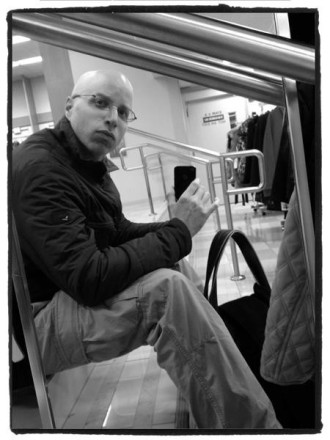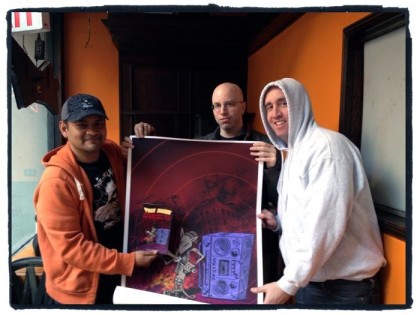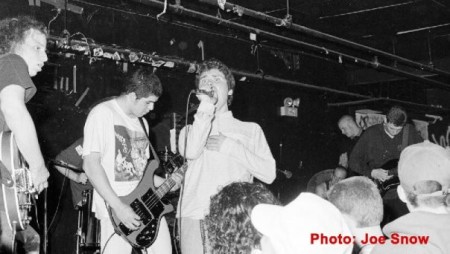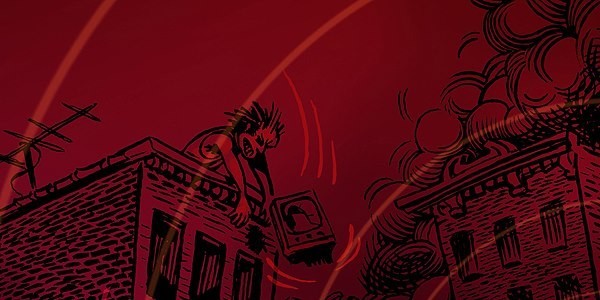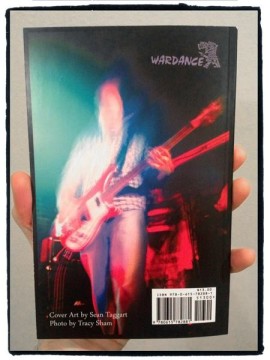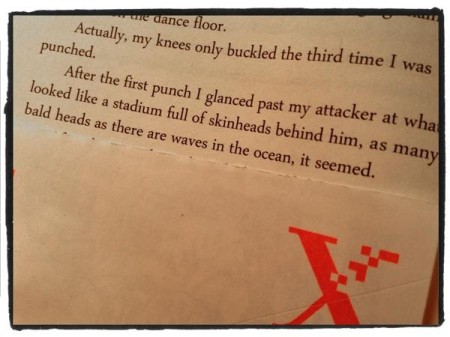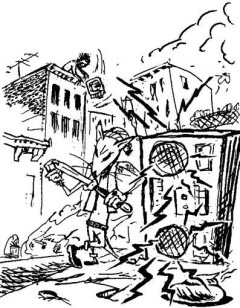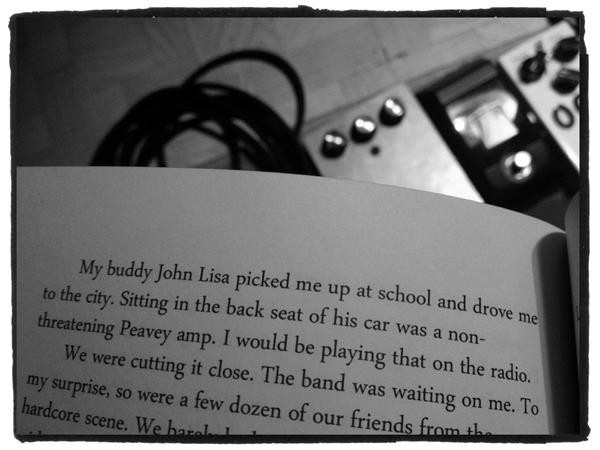“This Music” is a new book put out by author Lewis Dimmick and published by Wardance Records with some pretty damn good artwork by the one and only Sean Taggart who has quite a resume to say the least. Lew’s new book centers around his experiences of how he first discovered metal and then how he got into hardcore music back in the mid-late 1980’s in NYC. Lew went on to be in the band Our Gang where he played guitar and more recently he teamed up with a few other old NYHC friends to put out a 7” with his new band My Rifle (also on Wardance). This Music is a 66 page effort taking us through Lew’s personal stories and experiences ranging from first discovering his best friends father’s record collection (which included the Sex Pistols) to getting attacked by what looked like a stadium full of skinheads at a CBGB’s matinee. The stories are in some cases over 25 years old but still maintain their relevance as This Music had me reeled in from start to finish. Whether you’re and old timer or a first timer This Music has something for everyone from Iron Maiden to Reagan Youth. This April 2013 interview with Lew was done right as the book was getting ready to launch. A link to buy This Music is included at the end of the interview.
Artwork by Sean Taggart, Graphics by: Bas Spierings.
IE: Can you start off by telling us a little about who you are and your connections to the NYHC and punk scenes?
Lew: I am Lewis Dimmick. I used to play in a NYHC band called Our Gang and hung out at CBGB’s hardcore matinees from 1986 to 1989 or so.
IE: How and when did the idea to write a book go off in your head?
Lew: It was something I had been thinking about for a while, writing about music, but I couldn’t decide on how to approach it. Then one day I just started writing and things started to take a shape of their own.
IE: How long did everything take to put this together from start to finish?
Lew: About fifteen months I’d say. About a year writing and re-writing the pieces and a few months sorting out all the details: deciding how big the book should be, exactly what
the title should be, getting the art completed, the font, the size of the font, the amount of space in between lines, the kind of paper I wanted to use. In other words, lots and lots of small,
important decisions.
IE: Most of your recollections in the book are from your younger years and stretch back to the late 1980’s. If you are a teen or twenty something reading this it has little to do with the now sort of speak. How do you kinda draw them in to checking out your book?
Lew: As far as I know the youngsters, just like us old folks, love Bad Brains, Agnostic Front, Black Sabbath, etc. Good music speaks to all ages. In terms of NYHC, CBGB’s, stuff
like that, the younger people might be interested historically. I wrote the book to the best of my ability, and that is how I hope to draw in any kind of reader, by producing strong work.
IE: In the book you mention a time when you would stay home to record live sets off of WNYU’s Crucial Chaos Radio Show which would have bands play live on the air. Can you talk about how important that show was to you and give a little background on the show for those who may not have remembered it.
Lew: It was very exciting to discover the underground hardcore bands in NYC like Token Entry, Underdog, Warzone, etc. So to be able to hear these bands do interviews and play live on the radio was extremely cool. Crucial Chaos was a hardcore radio show on New York University Radio, showcasing all the bands from that time.
IE: You also mention that there were times where you would not hang out with your friends just to stay home and record the show?
Lew: I’m sure it happened once or twice. If Warzone was playing live on the air I would probably choose that over going out for pizza. I had discovered something really unique and powerful and I wanted to get as much of it as I could.
IE: A big draw for me to This Music was any mention or story about Our Gang who you played guitar for. Can you give us some insight to Our Gang and what the band accomplished in its brief history?
Lew: We recorded 4 live demos at Don Fury’s. Jack Roy Records released an LP of the demos a few years ago. We weren’t one of the best known bands in the scene but the people who knew us liked us a lot. We played with bands like Up Front, Pressure Release, Token Entry, Slapshot, Project X, Life’s Blood, and we played live on NYU. Our reunion in 2010 was by far the best show we ever played. We were, for the first time ever, super tight and able to bring across the power of the songs as Hobi and I had originally intended them. We got a great response. A lot of people stopped me afterward to tell me it was a great set and outside the club I saw a bunch of people walking around holding our LP. Very cool feeling.
IE: There is a funny section in the book where you talk about coming home and seeing your family playing Our Gang’s music in your house and you being embarrassed a bit. What made you feel insecure with the band’s music then?
Lew: It sucked! It was ridiculously sloppy. I guess there was a charm in that, but we didn’t exactly plan it to be that way.
IE: Would you ever consider going back and re-recording the old material and make a “proper” recording for Our Gang? Are you still in contact with the other members?
Lew: I’m not in regular communication with the old members. I’d be fine with recording anything but I really don’t see it happening. Everyone is pretty busy doing their own thing
and I don’t think we’d be able to top the reunion show we did for Chris Daily. That was one of those nights it would be silly to try to repeat.
IE: In 2011 you got together with Jason who used to sing for Lifesblood and put out a record under the band name My Rifle. Can you tell us about My Rifle a little? Jason now lives in Georgia I believe, wasn’t it a little odd making up a band with your singer so far from the rest of the band?
Lew: It’s not really too odd by today’s standards. Lots of recordings are done that way. We recorded the music in NY and sent the files to Georgia where he found a studio and
added the vocals. I’m really proud of our 4-song EP. Definitely the best recording I’ve ever been on.
IE: Out of all the stories in your book what are some of the ones that you like to retell the most?
Lew: I don’t really tell them that much. If I had told them lots of times there would have been no life in them left for the writing. I didn’t know exactly what I was going to write when I sat down to work on the book. A big part of it is discovering ideas in the process that you hadn’t planned on.
IE: You are not a big supporter of current day hardcore bands from what I gather. What do you think is missing these days and do you feel like you give the bands a fair shake for the most part?
Lew: The genuine hardcore sound is missing. Too many hardcore bands sound like Pantera.
IE: Are there any new bands playing hardcore or punk these days that you like?
Lew: I seem to be listening to more metal stuff. I like Kylesa, Red Fang. The latest Corrosion Of Conformity album was amazing.
IE: This Music is 66 pages and in my review of it I was mentioning I was left wanting more in regards to your stories. Some of them I felt were maybe shortened a little. You hinted that this may have been done intentionally for a possible sequal?
Lew: The writing style is understated, meaning I’m trying to create a feeling in the reader without explicitly stating every last thing I’m thinking. That’s what makes a book worth reading again; there’s something behind the words. That’s why I used the word “pieces” in the title. They are fragments, reflections, memories. They capture a moment. That kind of approach was influenced by studying poetry and most poetry books are about the length of this book. I’m definitely a believer in quality over quantity. You seemed disappointed in your review that the book was only 66 pages and it only took you 30 minutes to read. But you could always read it again. A book is more than the number of minutes it takes to read it. It was crafted with care. You might find something in it you didn’t catch the first time. Just a suggestion. Anyhow, there’s a connection with hardcore. Short songs, short pieces of writing. “Victim In Pain”, the greatest NYHC record of all time, is only about fifteen minutes long but I never found myself thinking it would be better if it was longer. I don’t have a sequel planned but I’d like to write more in the same vein.
IE: I have to bring up the part in the book where you are essentially jumped at a CB's show by one of the so called "Twins" and a "stadium full of skinheads". The twins were 2 guys generally known for being a menace in the pit at shows back then. Through it all you mention that the Gorilla Biscuits record came out that day and somehow you held on to it or retained it by the time you got home. Do you still have all of your old vinyl from back then?
Lew: No, I sold a bunch on eBay. I kept my favorite 45’s though. I kept the Token Entry 7”, Underdog, Warzone, The NYHC ’87 comp on orange vinyl, The Sick Of It All 7”, “End
The Warzone” I kept for Straight Ahead, the Some Records pressing of “Can’t Close My Eyes”, an original “Pay To Cum”, and I kept a copy of “Skins, Brains & Guts” that was given to me as a gift
from some of my friends back in the day. I mentioned that the writing style in the book is understated. Bringing up the Gorilla Biscuits record in that essay is a good example of that. I talk about
how I still had the record with me later that night and how it was important to me to support the bands I liked. What I really wanted to do by including that detail is illustrate a difference in
character. I wanted to point out, without explicitly stating it, that while violence is what motivated some people in the scene, what motivated me was a genuine love for music. At the end of the
essay I describe how a cop approaches this particular skinhead and stares him down and the skinhead looks back at the cop with disgust and hatred. The essay ends, “It was a look I’ve never given
anyone in my life.” The ending is also understated, illustrating a fundamental difference in character.
IE: Why are there no photos included? To me it seems like they would have added another dimension to your stories.
Lew: Because I wanted to do something different. There are plenty of books about hardcore with lots of photos, mostly photos in fact. But this is a personal account, a book that
tries to capture small, impressionable moments that all reflect back to a passion and reverence for music. To the best of my knowledge there’s not really another book like it.
IE: How did you go about tracking down Sean Taggart to draw the cover artwork?
Lew: I sent him a message on Facebook. I was very happy when he agreed because I’m a big fan of his work. Can’t say enough about it.
IE: When you got the finished product of This Music into your hands for the first time were you 100% satisfied with it?
Lew: I stand behind my book 100% and that’s a great feeling. I stand behind the writing, the art, the layout, everything. It was all put together with care and I’m proud of it.
IE: Is there anything you would go back and like to do over?
Lew: Nothing at the moment.
IE: What keeps you busy these days?
Lew: I teach writing and stay busy chilling with my girlfriend and our three cats.
IE: Anything else to add before we end?
Lew: Thanks Chris for having such a passion for music that you are still documenting it after
all these years. We’re getting old!







